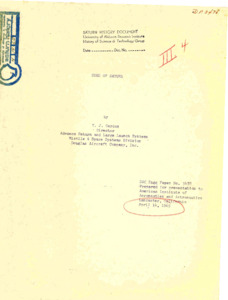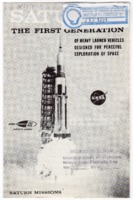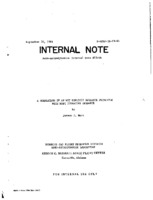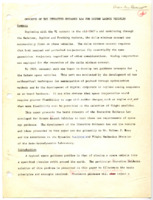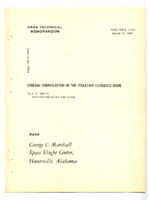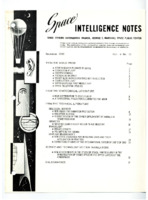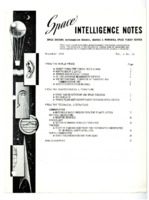
Browse Items (132 total)
Sort by:
-
"Uses of Saturn."
Saturn and Apollo hardware will not have realized their ultimate potential for space exploration after the project lunar landing is complete. To accomplish the Apollo lunar landing program, an immense backlog of technology, facilities, and booster capability will have been built up, and we believe proper utilization of this resource will fill the needs for planetary, lunar and earth orbital space exploration for years to come. -
"Saturn I: The First Generation of Heavy Launch Vehicles Designed for Peaceful Exploration of Space."
The leaflet outlines the history of Saturn launches and gives a physical description of the rocket. The description includes a diagram of each stage; specifications of each stage's thrust, propellants, liftoff weight, and burning time; and engine specifications. -
"A Comparison of an MIT Explicit Guidance Principle with MSFC Iterative Guidance."
From the summary: "Both [guidance] schemes steer toward a specified end point. The MIT scheme uses thrust to cancel out the effective gravity, a nonlinear term, which may be inefficient in certain cases. The MSFC scheme is more closely connected with calculus of variations and optimization theory in a reasonable degree of approximation." -
Draft of "Concepts of the Iterative Guidance Law for Saturn Launch Vehicles."
The summary notes, "In 1960, research work was begun to develop new guidance concepts for the Saturn space vehicles. [...] This paper presents the basics of the Iterative Guidance Law developed for Saturn launch vehicles to meet these new requirements of space age guidance. The development of the Iterative Guidance Law and the results and ideas presented in this paper are due primarily to Mr. Helmut J. Horn and his associates in the Dynamics Analysis and Flight Mechanics Division of the Aero-Astrodynamics Laboratory." Marked "Research Review, OK" in the upper right corner of the first page. The document includes corrections and additions to the text in red pencil. -
"General Formulation of the Iterative Guidance Mode."
From the abstract: "This report discusses the iterative guidance mode and its application to three-dimensional upper stage vacuum flight. It is an inertial or closed system mode in that the only inputs required after liftoff are available from the onboard navigation system. That is, the iterative scheme computes steering commands as a function of the state and of the vehicle - velocity, position, longitudinal acceleration, and gravitational acceleration - and the desired cutoff conditions. The guidance commands are updated each guidance cycle, using the updated state of the vehicle. The iterative guidance scheme is a path adaptive guidance scheme in that it will retain its optimization properties under all expected types and magnitudes of vehicle perturbations without any loss in accuracy at liftoff." -
Space Intelligence Notes, December 1963.
This is Vol. 4, No. 12 of Space Intelligence Notes, a publication of the Space Systems Information Branch at the Marshall Space Flight Center. According to the table of contents page, topics include various articles from the world press such as planned atomic research in Israel, the flight of Cosmos-21 and Cosmos-22, and the launch of Japan's first missile ship; from the semitechnical literature such as new constributions to space flight; from the technical literature includng biological sciences, chemistry, space flight, and units and measurements; science and technology section translations; and bibliographies. -
Space Intelligence Notes, November 1963.
This is Vol. 4, No. 11 of Space Intelligence Notes, a publication of the Space Systems Information Branch at the Marshall Space Flight Center. According to the table of contents page, topics include various articles from the world press such as rocket firing progress in India, the election of a new president, and the exchange of measurement experts between the US and USSR; from the semitechnical literature such as Soviet aims in astronomy and space research; from the technical literature including communication, materials engineering, space flight, tracking, and vehicle engineering; and bibliographies. -
Space Intelligence Notes, October 1963.
This is Vol. 4, No. 10 of Space Intelligence Notes, a publication of the Space Systems Information Branch at the Marshall Space Flight Center. According to the table of contents page, topics include various articles from the world press such as ice from space, US tracking station plans, the presence of intelligent beings on Mars, and sun eruptions possibly causing atomic geysers on the Moon; from the semitechnical literature such as sun power; from the technical literature including astrogeology, life support, materials engineering, physics, theoretical physics, and nuclear physics; and bibliography.
